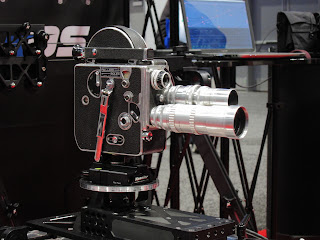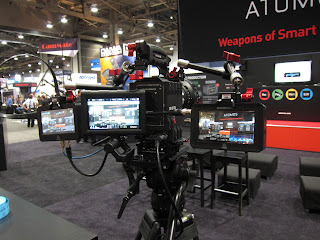Even though this blog is primarily aimed at video professionals and a business that serves those professionals, it's almost an industry accepted term to talk about "camera porn." There are always those pieces of gear that require you to perform at least one miracle that qualifies you for catholic saint-hood, a minimum of three Oscar wins, and knowing an inside man at Panavision before the manufacturer will let you touch it. Being a male dominated industry, we lust after what we can't have. Thus...camera porn.
As talked about in my previous post, Arri was there in full force. The Alexa shown below is equipped with a 35mm anamorphic lens...drool!. (Side note: Martin, when do we get a set of Zeiss anamorphics?) The Ultra Prime and Master Prime lenses were behind glass cases. After all, the fingerprint cleaning by an Arri tech in their class 1 clean room probably costs $1k/hr.
The picture that I wish would have turned out better was the setup with the Arri geared tripod head. After trying it out I want one! Financially speaking it's not going to happen. For now, I'm stuck with my "lowly" OConnor 1030D which I used to think was the best thing since sliced bread. Now I have tripod head envy. Note that this camera was also equipped with a 75mm anamorphic lens! I was pulling focus on this camera while a couple b-boys were onstage dancing. A couple guys behind me were commenting on how sharp the lens is. I told them it was the focus puller.




Blackmagic design stole the NAB show with their two announcements the night before the show opening. The first shocker is a point and shoot size cinema camera with a super-16 sensor, 13 stops of dynamic range, and lossless Prores/CinemaDNG recording! This is going to absolutely kill off DSLR video products. In fact, it will likely take a hard bite into GoPro's Black Edition camera. With a micro-4/3rd's lens mount you can adapt just about any lens to it. My Zeiss ZF.2's will work perfectly. The downside?...It still has rolling shutter. I gave the camera a little whip-pan and the rolling shutter was about as bad as a DSLR. Still, it's an awesome product for the price. On my way home I saw a friend in the airport and he had already purchased one online! The camera is *supposed* to be released in June.
The second shocker was a Production 4k camera. This has the same odd form factor and lack of XLR audio inputs as the current BMCC, but it has a super-35 size sensor and GLOBAL SHUTTER! the next step up to get 4k with global shutter is the Sony F55 at a body price of $26k!...and if you want raw it comes with the Blackmagic camera whereas the Sony requires another $7k bolt on box+battery+SSD. If and when the camera gets released I'm strongly considering a purchase. The ergonomics, connectivity, and controls aren't as nice as the Sony camera but at $4k who can argue? Did I mention the global shutter? Now the downside...Blackmagic said that the dynamic range will only be 11-12 stops and the target native ISO is 400. So the Sony/Red solutions have the Blackmagic camera clearly beat in technical performance.





Convergent Design had their interesting new Odyssey 7 recorder/monitor solution. The concept is that you rent codecs on a pay as you go basis. So if you need Arri raw, you can rent it for a few days. Need Prores HQ, rent it. The rep said that they will also offer the option of purchasing the codecs. At $1300 the Odyssey 7 makes a great OLED field monitor with true blacks. My guess is that in a few years you'll be hard pressed to find an LCD field monitor from anyone but the Chinese knock-off folks. The Odyssey 7 comes with a full set of scopes and for another $1k you get more 4k support including FS-700 4k raw. Given the size of this panel, I would like to see them produce a 5" version as well so the monitor doesn't dominate the camera as is does in the photo with the Epic below.
The other interesting product I saw at their booth showed a collaboration with I/O Industries. The IOI camera has a 2/3" sensor with global shutter and allows for a number of lens mount options including electronic control of Canon EF lenses. Here, the camera is mostly shown with c-mount lenses. The downside to this solution is the lack of built in battery and monitoring options, but the camera does output 1080p and 2k streams over SDI with over cranking, including raw. Every solution has its positives and negatives, but I can clearly see this solution being used in action and motor sports...maybe even reality shows for POV shots. Just think about the Act of Valor Navy Seal POV shots.
This is a well defined picture of camera porn. I wasn't even allowed to take a picture of the other half of the Leica glass case! Martin...anamorphic lenses...just saying.
Panasonic didn't have any new cinema cameras to show, but they were showing the new P2 format, which is the SD Card form factor. The difference between a standard SD Card and the P2 card is mainly guaranteed performance. As anyone who has bought "the great deal" on SD Cards knows, card reliability and throughput varies wildly with cheap/generic cards. Panasonic will also allow Class 10 SD Cards to be used in their new P2 cameras. Since PCMCIA is pretty much dead this seems like a great upgrade path for Panasonic customers.
So...speaking of performance...I'm not sure which booth this picture was taken in, but someone was showing off the Phantom cameras including the new "affordable" (it's a relative term) Phantom Miro. Definitely camera porn. Las Vegas will probably be the only place I see these cameras.
Red has been building on the concept of a digital motions/stills camera for some time. The mount in the first picture below allows you to swing the camera 90-degrees clockwise in case you want to record in portrait mode.
Red was also showing off their "global shutter". This shutter solution is installed as an optional lens mount and is an LCD that they place in front of the sensor. You lose 1 stop of light, but with the Dragon sensor coming in at a native sensitivity of 2000 ISO, who cares? The demo consisted of a TV screen and a spinning fan. Both behaved properly when the global shutter was turned on. It can be electronically turned off via the control panel, but then you would clearly see the jello-cam return.
In classic Jim Jannard fashion, Red was building Dragon sensor cameras on the show floor in a portable clean room. Anyone who has dealt with Red knows about Red's lack of credibility with regard to delivery schedule. This move may shut the critics up for a bit...or people may ask, where's my camera? I saw it being built at NAB!
Sony F5 and F55 cameras were EVERYWHERE at NAB. Every rental house, catalog company, or large equipment supplier had an F55 in their booth. The main way you can tell them apart is by the PL mount color. The F55 PL mount is silver. The F5 PL mount is black. It was fairly clear that Sony's dual bombshell offerings are going to be very popular in production in the coming year.
We stopped by the Sony booth and talked with Jody Eldred, who had recently done a camera event at Video Gear. He took the F55 out to Red Rocks and shot back lit skies against the rocks in raw. The color grading guy at the Sony booth was able to recover both the sky and the rocks is Davinci Resolve from the raw footage! There's no way either would survive with a DSLR or any 8-bit compressed codec. The camera does a true 14 stops, just like the Alexa, but with global shutter, and at 1/3rd the cost!
The F55 includes 4k internal recording onto SXS Pro+ cards ($1k+), whereas the F5 only records 2k and HD internally. The F55 can over crank to 240fps, whereas the F5 "only" goes up to 120fps. So there is a clear differentiation in technical performance. For documentaries the F5 seems good enough, but for action sports and commercials the F55 has an advantage. Another technical advantage of the F55 is that it has the same wide DCI color gamut of the F65, mainly for cinema use. The F5 is limited to rec.709 color gamut.
Sony also showed their FS-700 raw solution. It's real, but it's not quite what I thought it would be. The solution takes multiple parts: A $3k cable break-out box, a $5k raw recorder, at least one SSD at $1k (everyone will want at least two), and a V-mount battery brick at $500-$1k. So that little $8k camera turns into a $18-19k camera that doubles in size and probably triples in weight. At a certain point it just makes more sense to get the F5 if you really need raw or just a high quality direct to edit codec. I don't believe the FS-700 raw option firmware includes S-LOG2, so the F5 seems like a better option if you're trying to obtain high quality footage with a light weight camera setup.



Atomos
showed their update to the Samurai product called the Samurai Blade, which is mostly an upgrade to a high resolution IPS panel version of the Samurai. If you read my previous review of the Samurai the LCD panel was a weak point of their product so this is a welcome improvement. The Samurai Blade also includes a full set of scopes, just like the Convergent Design product. The supported codecs are still limited to Prores and DNxHD 10-bit 4:2:2, but those are very nice and easy to use codecs.
Part 3 comes next week when I'll wrap up the remaining stuff.
 Instructor Bio:
Instructor Bio:































































